Table of contents
5 Facts about a Metabolism Test at Home
- Purpose: A metabolism test at home is an easy and effective way to obtain information on key hormones that regulate your metabolism. The purpose of this health test is to identify abnormal levels that may be affecting weight and energy levels.
- How it Works: When you visit the website, you are presented with the option of ordering a kit, which usually arrives within 5-7 days. Prepare the blood and saliva samples, ship, and wait for results in your email.
- Cost: The cost varies greatly, starting at $49 for some tests and increasing up to $99. It is important to note that not many companies offer this test as an all-in-one package but instead offer tests separately at an average price of $60 each.
- Results: As with most at-home tests, you should get your results in a short time, sometimes within two days after sending your samples.
- Recommended product: Nebula 30X Whole Genome Sequencing is a reliable DNA Test that decodes all of your genetic blueprints with high accuracy
What is a Metabolism Test at Home?
Many life-quality markers are dependent on your metabolism. These include your mood, how you feel in general, how fast you burn calories, and how well you sleep. A metabolism test at home can help identify problems before they become serious.
Metabolism is the combination of all the chemical reactions taking place in your body to transform nutrients into energy. All living things stay alive because of this process. In simple terms, through metabolism, the body breaks down the calories you eat. Then, the body converts the broken calories into the energy your body needs to function correctly. Energy levels and weight are especially affected by this process.
Types of metabolism tests
We are concerned with good oxygen use and the number of calories you burn, and how fast you burn them while performing physical activities. Four types of tests measure your metabolic rate.
Resting metabolic rate (RMR) test
Just like the name suggests, this test measures the rate of how many calories your body burns while at rest. There are two ways of performing this test:
- Direct calorimetry: You are placed inside a calorimeter (a large insulated air-tight chamber) that measures the amount of heat your body releases while resting.
- Indirect calorimetry: Through this method, the specialist uses a device to measure the amount of oxygen you consume and compare it to the amount of carbon dioxide you exhale while at rest
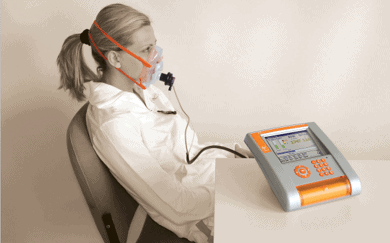
To get this test done, you must visit a certified professional.
VO2 max test: Also called the aerobic capacity test, this test provides information on how your body uses oxygen and burns fats during different exercises and intensity levels.
These tests are different depending on the person being tested. It could be running on a treadmill or riding a stationary bike. In general, the individual tested breathes into a mask, and the testing runs until it becomes too intense or until the testing time is over.
You also need to visit a trained professional to take this test.
Lactate threshold test: This is the VO2’s equivalent for athletes. In this type of testing, the individual undergoes intense routines to the point where the body can no longer supply oxygen to burn calories, and lactate begins to set in.
This is when lactic acid bathes the muscles, and they begin to fatigue. Blood is drawn during different activity levels.
A medical setting is needed for this test, and it must be done by an exercise physiologist.
Influential metabolic hormones test: This test measures the levels of hormones responsible for triggering metabolic reactions. Typically, these tests measure testosterone and thyroid stimulating hormone (TSH) as well as cortisol and progesterone.
Measuring these hormones provides a good picture to specialists of your entire body’s metabolism performance.
This is the type of test that you can perform in the comfort of your home by ordering a metabolism test at-home kit.
Biological markers
Your test results measure the amount of TSH, cortisol, testosterone (or progesterone) in your blood to help determine your overall metabolic health.
Cortisol: Every day, your body produces cortisol in your adrenal glands (located on top of your kidneys). This hormone regulates the release of glucose (blood sugar), which is the primary fuel that keeps us up and going throughout the day.
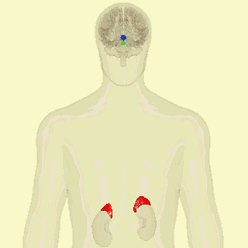
Cortisol is also the body’s main stress hormone. Besides that, there are other essential functions of this hormone:
- Keeps inflammation in check
- Regulates blood pressure
- It helps keep a good sleep
- Controls your use of fats, carbohydrates, and protein
When cortisol levels are too low, the hypothalamus and the pituitary gland, both located in the brain, adjust the number of hormones produced by signaling the adrenal glands.
Low and high levels of cortisol can trigger low metabolism, which is characterized by the following symptoms:
- Fatigue
- Depression
- Poor concentration
- Compromised memory
- Weight gain
TSH: The thyroid-stimulating hormone is secreted by the pituitary gland and controls hormone production by the thyroid gland.
When a person suffers hypothyroidism (low levels of T3 and T4), there is an increase in TSH. Higher thyroid-stimulating hormone is associated with a higher body mass index.
Thyroid conditions are more easily found with a TSH screening test. A metabolism test at home will compare your levels with those of average thyroid-stimulating hormone production. The results are an important monitor of your thyroid health.
Free testosterone: Testosterone is produced in the testes in men and the ovaries in women. Small amounts are also produced by the adrenal glands in both males and females. It is an androgen, meaning that it stimulates the development of masculine traits.
Testosterone that is bound to a protein in the blood is an inactive form. Metabolism tests will measure the amount of free testosterone in its active form.
When these hormone levels are within the normal range, it helps break down body fat and build muscle mass. Both men and women need optimal levels for proper muscle function and fitting body composition. When your body releases testosterone into the bloodstream, a group of receptors known as “androgen receptors” bind them and send a signal to stimulate the production of more protein-the building blocks of your muscles.
Abnormal testosterone levels will seriously affect your metabolism and overall health, so it is important to keep that one in check.
To maintain your levels at an optimal range, doctors recommend regular exercise, especially weight-lifting. Lower testosterone levels affect men and women differently.
Free progesterone: Most tests will not include both a testosterone and progesterone test, as the former should be enough to determine your metabolic state. However, it is important to point out that progesterone also plays a role in the metabolism of lipids, carbohydrates, and proteins.
How Much Does a Metabolism Test at Home Cost?
The market does not offer too many all-in-one at-home metabolism tests. In most cases, you can take a separate test for each hormone. As of right now, EverlyWell provides an affordable option to test metabolic hormones.
- EverlyWell: $49. You may also become a “Control member” for a monthly $24.99 subscription and get one test per month. Their metabolism test is included in this subscription.
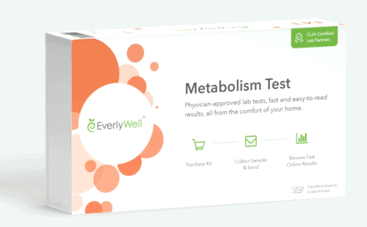
- Imaware: This company does not offer a complete metabolic panel but tests for TSH and total testosterone.
- TSH: $69
- Testosterone: $52
- My Labbox: $99
- Rx HomeTest: $84.99
Getting Started with Metabolic Testing at Home
You will not get too many options for a metabolism test in the market, at least not an all-in-one test. A metabolism test at home, though, is easy and quick. As usual, the first step will be to order the kit from your preferred provider.

Within days, you will receive your kit with instructions and everything you need to take your test. This particular one will require you to send blood and saliva samples. Most companies will need drops of blood, which you will place on the circles provided in a collection card.
If a tester requires a larger amount of blood, they will usually include a small collection tube plus the one needed to collect saliva.
A typical at home testing kit will include:
- Instructions and registration information
- Pre-paid return envelope
- Cotton gauze
- Band-aid
- Lancets and alcohol pads
- Biohazard bag
- Collection card
- Collection tube (for saliva sample)
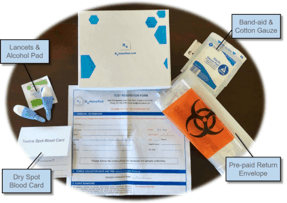
Upon receiving the kit, the first thing to do is to register that kit on the website. There is usually a highly visible button that users can go to.
To obtain a sample for this test, you do not need to make any dietary changes or fast. As with medication, you must consult with your doctor if it is safe to suspend their use.
Drink some water half an hour before to help the production of saliva. Using the lancet, prick your finger and place the blood samples on the collection card. Collect enough saliva per recommendation on the instructions sheet.
Place your samples into the biohazard bag and mail them back. You should receive your results within two days.
Metabolism Test at Home Results
Results are as accurate as those that you would get in a lab. You can share them with your physician to plan a strategy for you to improve your levels if necessary. Your results will usually include suggestions on what your next steps will be.
We still recommend you share your results with your care provider to better establish the course of action.
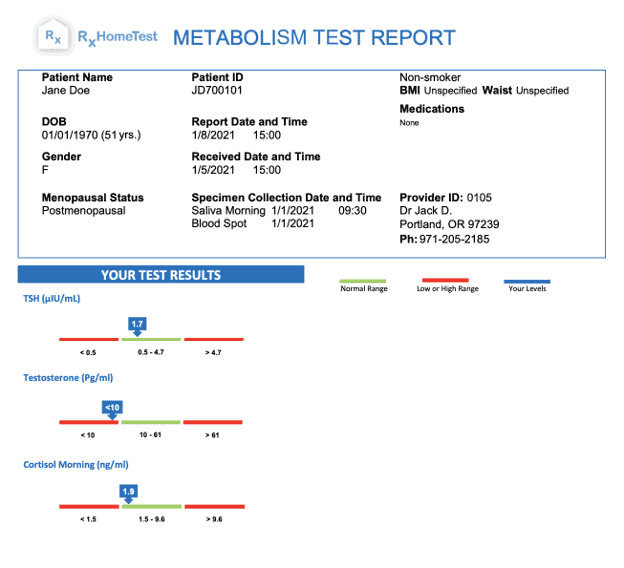
A metabolism test at home is recommended for those who are inexplicably gaining weight at a fast rate, suspect that they have a slow metabolism, or have trouble reaching a weight-loss goal. It could even be taken if you want to know how well your system is working.
By checking the levels of the tested hormones, you can identify a hormonal imbalance that could wreak havoc in your body if not treated on time. As with how frequently you should do a metabolism test at home, establish a goal to get your levels back to normal and decide which is the best time to assess results.
You may also be interested in these other wellness tests you can take from home:
- Women’s health test (hormones, cholesterol, nutrients, and more)
- Men’s health test (hormones, proteins, cholesterol, and more)
- Heart health test (cholesterol and other lipids)
- Inflammation test (CRP, vitamin D, Procalcitonin, and more)
- Vitamin D test (hydroxyvitamin D levels)
- Cholesterol test (total cholesterol, HDL, LDL, and triglycerides)
- Thyroid test (TSH, FT4, FT3, and TPO)
- Testosterone test (total, free, SHGB binding, albumin binding)
- Food sensitivity test (immune response to up to 600 foods)
Edited by: Christina Swords, PhD
